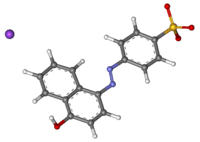FD&C Orange Number 1
 | |
 | |
| Names | |
|---|---|
| IUPAC name
Sodium 4-[2-(4-oxonaphthalen-1-ylidene)hydrazin-1-yl]benzenesulfonate | |
| Other names
Acid orange 20 Orange I | |
| Identifiers | |
| 523-44-4 4-{2-[(1E)-1-ylidene]-1-yl} | |
| 3D model (Jmol) | Interactive image |
| 3826844 | |
| ChemSpider | 7844542 4-{2-[(1E)-1-ylidene]-1-yl} 14466524 4-{2-[(1Z)-1-ylidene]-1-yl} |
| ECHA InfoCard | 100.007.589 |
| EC Number | 208-346-6 |
| PubChem | 23666138 4-{2-[(1E)-1-ylidene]-1-yl} 23721617 4-{2-[(1Z)-1-ylidene]-1-yl} |
| RTECS number | DB7085000 |
| |
| |
| Properties | |
| C16H11N2NaO4S | |
| Molar mass | 350.32 g·mol−1 |
| Hazards | |
| S-phrases | S22, S24/25 |
| NFPA 704 | |
| Except where otherwise noted, data are given for materials in their standard state (at 25 °C [77 °F], 100 kPa). | |
| Infobox references | |
_(7395989690).jpg)
FDA explanation of Orange Number 1
FD&C Orange Number 1 was one of the first water soluble dyes to be commercialized, and one of seven original food dyes allowed under the Pure Food and Drug Act of June 30, 1906.[1] In the early 1950s, after several cases were reported of sickness in children who had eaten Halloween candy colored with the dye, the FDA conducted new, more thorough and rigorous testing on food dyes.[2] Orange 1 was outlawed for food use in 1956.[3]
References
- ↑ "News of Food; U. S. May Outlaw Dyes Used to Tint Oranges and Other Foods". The New York Times. 1954-01-19.
The use of artificial colors to make foods more attractive to the eye may be sharply curtailed by action of the United States Food and Drug Administration. Three of the most extensively used coal tar dyes are being considered for removal from the Government's list of colors certified as safe for internal and external use and consumption.
- ↑ Malia Wollan (October 5, 2016). "Brand New Hue: The Quest to Make a True Blue M&M". The New York Times Magazine. Retrieved October 8, 2016.
...nearly every rat and dog given Orange No. 1 showed signs of distress, ranging from weight loss to death.
- ↑ Maga, Joseph A.; Anthony T. Tu (1995). Food additive toxicology. CRC Press. p. 182. ISBN 0-8247-9245-9.
This article is issued from Wikipedia - version of the 10/8/2016. The text is available under the Creative Commons Attribution/Share Alike but additional terms may apply for the media files.
